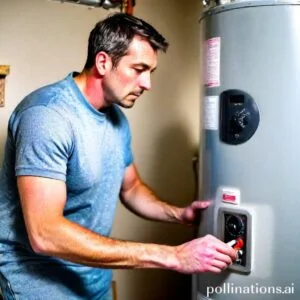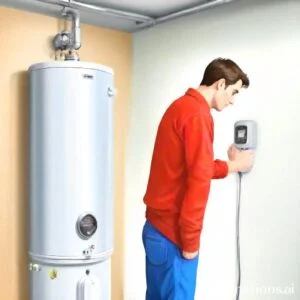
II. Signs of a failing water heater temperature control include inconsistent water temperature, unusual noises, and leaks around the water heater.
III. If you notice any of these signs, it is important to seek professional help to repair or replace the temperature control to avoid potential hazards such as scalding, electrical fires, or flooding.
The temperature control is a crucial component of a water heater that regulates the water temperature. If it starts to malfunction, it can lead to a variety of issues, including scalding hot water, lukewarm water, or no hot water at all.
In this article, we’ll discuss the signs of a failing water heater temperature control, how to troubleshoot the issue, and when to call a professional for help. By grasping these key points, you can ensure the optimal performance of your water heater and avoid any potential hazards.
Symptoms of a Failing Water Heater Temperature Control
Inconsistent Water Temperature
Fluctuating water temperature can be a frustrating issue for homeowners. One moment you’re enjoying a warm shower, and the next, you’re blasted with icy cold water. This inconsistency can make daily routines uncomfortable and inconvenient.
Several factors can contribute to fluctuating water temperature in a failing water heater temperature control. It could be due to a malfunctioning thermostat, sediment buildup in the tank, or a faulty heating element. These issues can disrupt the balance between hot and cold water, resulting in unpredictable temperature changes.
The effects of inconsistent water temperature can be significant. It can make showering or bathing uncomfortable, especially when sudden temperature changes occur. It can also affect other household activities that rely on hot water, such as doing the dishes or laundry.
Water Too Hot or Too Cold
Extreme water temperature is another common symptom of a failing water heater temperature control. When the control mechanism malfunctions, it can cause the water to become excessively hot or cold.
There are various causes for extreme water temperature. A faulty thermostat can fail to regulate the water temperature properly, leading to scalding hot water. Nevertheless, a malfunctioning heating element may not heat the water adequately, resulting in cold showers.
Dangers arise when the water becomes extremely hot. Scalding hot water can cause burns and injuries, particularly in young children or the elderly. Additionally, excessively hot water can also damage appliances and plumbing fixtures, such as dishwashers, washing machines, and pipes.
No Hot Water
The absence of hot water is a clear indication of a failing water heater temperature control. It can be incredibly inconvenient, especially in colder climates or during winter months.
No hot water can be caused by various factors. A malfunctioning thermostat may fail to signal the heating element to heat the water. Electrical issues or a tripped circuit breaker can also result in a lack of hot water.
The effects of having no hot water can disrupt daily routines. It can make showering or bathing uncomfortable, and tasks such as washing dishes or doing laundry may become more challenging.
| Symptom | Possible Causes | Effects |
|---|---|---|
| Inconsistent Water Temperature | Malfunctioning thermostat, sediment buildup, faulty heating element | Uncomfortable showers, disrupted daily routines |
| Water Too Hot or Too Cold | Faulty thermostat, malfunctioning heating element | Burns and injuries, damage to appliances and plumbing |
| No Hot Water | Malfunctioning thermostat, electrical issues, tripped circuit breaker | Inconvenience, disrupted daily routines |
Reasons for Failing Water Heater Temperature Control
1. Sediment Buildup
Sediment buildup in a water heater can lead to issues with temperature control. Over time, minerals and other substances in the water can settle at the bottom of the tank, creating a layer of sediment. This buildup can insulate the heating element, preventing it from efficiently heating the water.
Causes of sediment buildup can vary, but one common factor is hard water. Hard water contains high levels of minerals such as calcium and magnesium, which are more likely to precipitate and form sediment. Additionally, lack of regular water heater maintenance, such as flushing the tank periodically, can contribute to sediment accumulation.
The effects of sediment buildup on temperature control can be significant. As the sediment layer thickens, it acts as an insulator, reducing the transfer of heat from the heating element to the water. This can result in inconsistent water temperatures and longer heating times, leading to discomfort and inconvenience for users.
2. Thermostat Malfunction
A malfunctioning thermostat is another common reason for water heater temperature control issues. The thermostat is responsible for regulating the temperature of the water by turning the heating element on and off as needed. When the thermostat malfunctions, it can fail to accurately sense and control the temperature.
Causes of thermostat malfunction can include electrical issues, faulty wiring, or simply wear and tear over time. In some cases, the thermostat may become out of calibration, leading to inaccurate temperature readings and improper control of the heating element.
The effects of thermostat malfunction on temperature control can be frustrating. The water heater may not heat the water to the desired temperature, resulting in water that is too hot or too cold. This can make it difficult to perform daily tasks such as showering or washing dishes, and can also lead to energy wastage.
How to Test a Water Heater Temperature Control
1. Tools Required
- List of required tools
- Demonstration of each tool’s purpose
Relating to testing a water heater temperature control, integral to have the right tools at hand. Here is a list of the tools you will need:
- Thermometer: This tool is used to measure the temperature of the water.
- Screwdriver: A screwdriver is needed to remove the access panel of the water heater.
- Electrical tester: This tool is used to check the electrical connections and ensure everything is functioning properly.
2. Testing Procedure
- Step-by-step instructions for testing temperature control
- Demonstration of testing results
Testing the temperature control of a water heater is a straightforward process. Follow these steps:
- Step 1: Turn off the power to the water heater by switching off the circuit breaker.
- Step 2: Remove the access panel of the water heater using a screwdriver.
- Step 3: Locate the temperature control dial, which is usually found near the bottom of the tank.
- Step 4: Use a thermometer to measure the temperature of the water. Place the thermometer in a cup of water and wait for a few minutes.
- Step 5: Compare the temperature on the thermometer to the temperature setting on the control dial.
- Step 6: If the temperature on the thermometer matches the setting on the control dial, then the temperature control is working correctly.
- Step 7: If the temperature on the thermometer does not match the setting on the control dial, then the temperature control may need to be adjusted or replaced.

How to Replace a Failing Water Heater Temperature Control
1. Tools Required
- List of required tools: This section provides a comprehensive list of all the tools you will need to replace a failing water heater temperature control. Having these tools ready beforehand will ensure a smooth and efficient replacement process.
- Elucidation of each tool’s purpose: Each tool listed in this section is explained in detail, highlighting its specific purpose in the replacement procedure. Embracing the purpose of each tool will help you use them effectively.
2. Replacement Procedure
- Step-by-step instructions for replacing temperature control: This section guides you through the replacement process with clear and concise step-by-step instructions. Following these instructions carefully will help you successfully replace the failing water heater temperature control.
- Illustration of replacement results: After completing the replacement procedure, this section explains the expected results. It provides an assimilating of how the new temperature control will function and the benefits it will bring to your water heater.
Note: The information provided in this outline is part of a longer article that focuses on water heater maintenance and troubleshooting. It is specifically designed to assist you in replacing a failing water heater temperature control. By heeding these instructions and having the necessary tools, you can ensure the efficient functioning of your water heater.
| Tool | Purpose |
|---|---|
| Adjustable Wrench | Tightening and loosening nuts and bolts |
| Screwdriver | Removing and securing screws |
| Wire Strippers | Stripping and cutting wires |

Preventative Maintenance for Water Heater Temperature Control
1. Regular Flushing
Regular flushing of your water heater is essential to ensure its optimal performance and longevity. Flushing involves draining the tank to remove sediment and mineral build-up that can accumulate over time.
Clarification of regular flushing: Flushing your water heater involves attaching a hose to the drain valve and allowing the water to flow out until it runs clear. This process helps remove any sediment or debris that may have settled at the bottom of the tank.
Benefits of regular flushing: By regularly flushing your water heater, you can prevent sediment from accumulating, which can lead to reduced heat transfer and lower efficiency. Flushing also helps extend the lifespan of your water heater and reduces the risk of costly repairs.
Recommended flushing frequency: It is recommended to flush your water heater at least once a year to maintain its efficiency and performance. Nevertheless, if you live in an area with hard water, more frequent flushing may be necessary.
2. Annual Inspection
An annual inspection of your water heater is crucial to identify any potential issues and ensure its safe operation. It involves checking various components and verifying that everything is functioning correctly.
Illustration of annual inspection: During an annual inspection, a professional technician will examine the water heater’s elements, thermostat, pressure relief valve, and other crucial parts. They will also inspect for any signs of leaks, corrosion, or other damage.
Benefits of annual inspection: Conducting regular inspections helps identify and address minor issues before they escalate into major problems. It ensures that your water heater operates efficiently, minimizes the risk of breakdowns, and improves overall safety.
Recommended inspection frequency: It is recommended to have your water heater inspected by a professional once a year. This ensures that any potential issues are promptly addressed and helps maintain the longevity and performance of your water heater.
| Flushing Frequency | Inspection Frequency |
|---|---|
| At least once a year | Once a year |
Bottom Line
In conclusion, a failing water heater temperature control can cause a range of issues, from scalding hot water to lukewarm showers. It’s important to keep an eye out for signs of a malfunctioning control, such as inconsistent water temperatures or strange noises coming from the unit. If you suspect that your water heater temperature control is failing, it’s best to call a professional to diagnose and repair the issue. Regular maintenance and inspections can also help prevent problems before they occur. Don’t wait until it’s too late – take action to ensure that your water heater is functioning properly and providing safe, reliable hot water for your home.
Read More:
1. Impact Of Temperature On Water Heater Performance
2. How Does Sediment Affect Water Heater Temperature?














